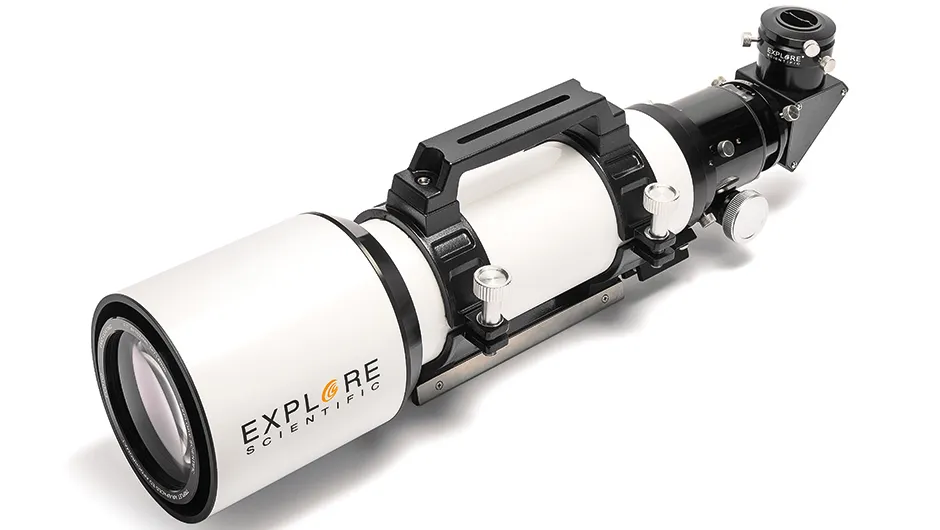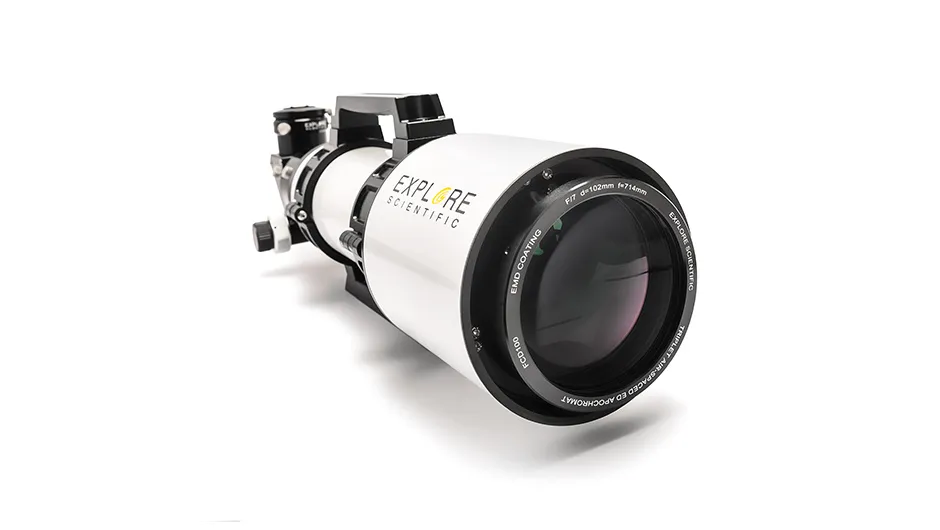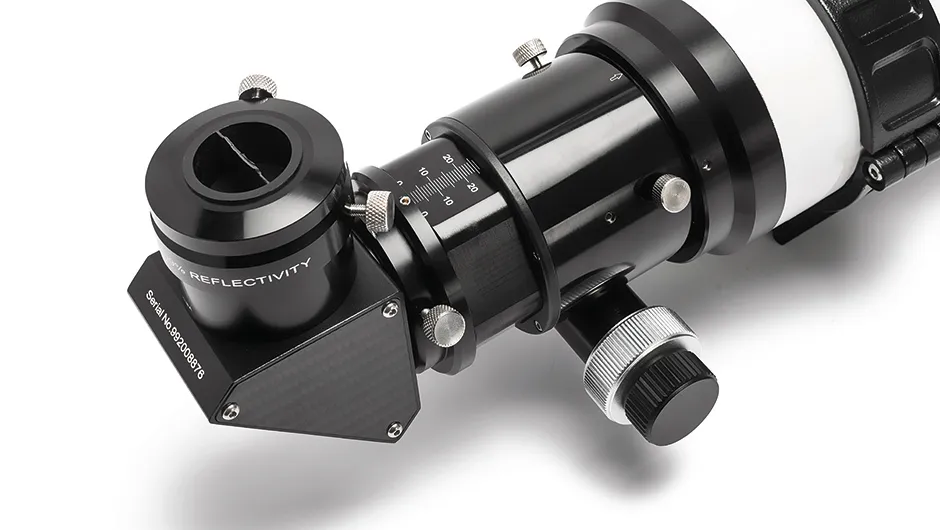The Explore Scientific ED APO 102mm f/7 Deluxe FCD-100 Hex-Focus is a short focus refractor.
It is sold as a tube-only configuration packaged with tube rings, two focuser-extension adaptors and a star diagonal.
Of course, this is a double-edged sword: buying a tube alone means you can use accessories you already own, but if you are starting out you need to factor in the cost of completing your setup.
The scope’s dew shield is fully retractable and the protective lens cover fits snugly over the main objective lens rather than the shield itself, a welcome element of the design.
The tube is made of aluminium and is quite short at 560mm, though that is without a star diagonal or extension adaptors, and with the dew shield retracted.
Its diameter is 106mm. It is a lightweight 4kg, making it easy to carry and to attach to a mount; it’s another suitable candidate for a grab-and-go system.
The tube rings are sturdy and have an integrated carry handle, which we found useful when taking the telescope out to our mount.

The carry handle also has a mounting slot for a camera for piggyback astrophotography. The focuser is the 2.5-inch Hexafoc 10:1 DeLuxe, which has 44mm of focus travel.
It can be rotated to allow better camera framing for astrophotography and locked into position with a single screw, which we found did the job well.
Tension can be applied to the focuser via the tension screw underneath and locked into place with the two upper screws if you are using a large or heavy camera.
The objective is 102mm (4 inches) in diameter with a focal length of 714mm.This gives a short focal ratio of f/7, which is useful for astrophotography.
The objective lens has enhanced multilayer desposition (EMD) coatings – these improve contrast and light transmission, and give the front of the lens a subtle green hue.
In our tests we were very pleased with the quality of the optics, with no colour fringing noticeable on stars.
Looking specifically at Altair, the alpha star of Aquila, we found it to be pin sharp across almost the whole of the view using our own 26mm, 1.25-inch eyepiece; an impressive view replicated when we switched to a 26mm, 2-inch eyepiece with a 100° field of view.
Going deeper

When we attached the telescope to our own NEQ6 mount, we found that we had to use one of the supplied focuser extension adaptors to achieve focus with the star diagonal and our chosen eyepieces.
We took a tour of some of the night’s greatest deep-sky sights: the galaxy pair of M81 and M82 in Ursa Major; the Andromeda Galaxy and its companions M32 and M110; the Dumbbell Nebula in Vulpecula; the Ring Nebula in Lyra; the Wild Duck Cluster in Scutum; the galaxy NGC 7331 in Pegasus; and M13, the Hercules Globular Cluster.
Adding a 2x Barlow lens we enjoyed good crisp views of our targets, with the Dumbbell Nebula and M13 especially pleasing to the eye.
We even added a 5x Tele Vue Powermate to our 26mm, 1.25-inch eyepiece and enjoyed good views of the triple star Iota Cassiopeiae.
Later in the month, a glimpse of the Moon close to a low-lying Saturn completed the visual tour.
Impressive imaging

When it came to using the scope with a DSLR, we found that the two extenders were not quite enough for prime focus photography (ie, using the scope as the camera lens), but by using just one extender plus the star diagonal we were able to achieve focus with our Canon EOS 50D DSLR, which has an APS-C sensor.
We concentrated on two main targets, the Dumbbell Nebula and the Andromeda Galaxy, taking several two-minute exposures at ISO 1600, and we were pleased with the detail captured after processing them.
The quality of the stars was sharp, with only the edges showing a little distortion.
Switching to our own ZWO ASI224C high frame rate colour camera we imaged triple star Iota Cassiopeiaeand the double star Almach in Andromeda, and achieved good resolution images of both.
Overall, we found the telescope a delight to use and were most reluctant to part with it.
Explore Scientific ED102 FCD-100's triplet lens
Unlike long focus refractors, those with short focal lengths can suffer from colour fringing.
This occurs when not all colours are brought to the same focal point, leading to vibrant haloes around bright stars and the edge of the Moon.
Visually it can be a little distracting for casual stargazers, but for astrophotographers and committed visual observers it can render a telescope useless.
Doublet and triplet lens elements are employed to control the colour fringing.
The front objective lens of the Explore Scientific ED102 FCD-100 is a triplet of air-spaced HOYA FCD-100 glass, and it provides good contrast and colour correction.
This in turn is helped by Explore Scientific’s enhanced multilayer desposition (EMD) coatings on the lens.
We saw little evidence of any colour fringing in either visual or imaging use; the view was very crisp with well-controlled stars almost to the edge of the view.
Explore Scientific ED102 FCD-100: 5 best features
Dew shield
The dew shield was very smooth in operation and is retractable, making the refractor quite short.When the shield is retracted you can access the objective cell collimation screws, although you should not have to adjust these often.
Tube Rings
The ES ED102 FCD100 is equipped with cradle-style tube rings and a Vixen-style mounting bar with a stainless-steel strip to protect it when attaching to a mount.The rings are sturdy and have a strong carry handle built into the top, making carrying and setting up easier.
Star diagonal
The supplied star diagonal is a 2-inch fit, but a 1.25-inch adaptor is also included in the box, so you can use eyepieces of both sizes.The diagonal has a reflectivity of 99 per cent and proved vital in achieving focus with a DSLR.
Focuser
The 2.5-inch Hexafoc 10:1 Deluxe focuser has a 10:1 dual speed gear ratio and 44mm of focus travel.It’s smooth in operation and can be rotated through 360°, allowing for easy camera framing.A tension screw and two additional upper screws allow heavy equipment to be used without the focus slipping.
Focuser Extension Adaptors
One way of keeping a telescope physically small is to make it shorter than the focal length of its optics but provide additional extension tubes or adaptors.This allows you to alter the focus point as required for both observing and astrophotography.
Vital stats
Price: £1267.00
Aperture: 4-inch
Focal Length: 714mm (f/7)
Weight: 4kg
Supplier: Telescope House
Telephone: 01342 837098
Website:www.telescopehouse.com
This review originally appeared in the November 2017 issue of BBC Sky at Night Magazine
